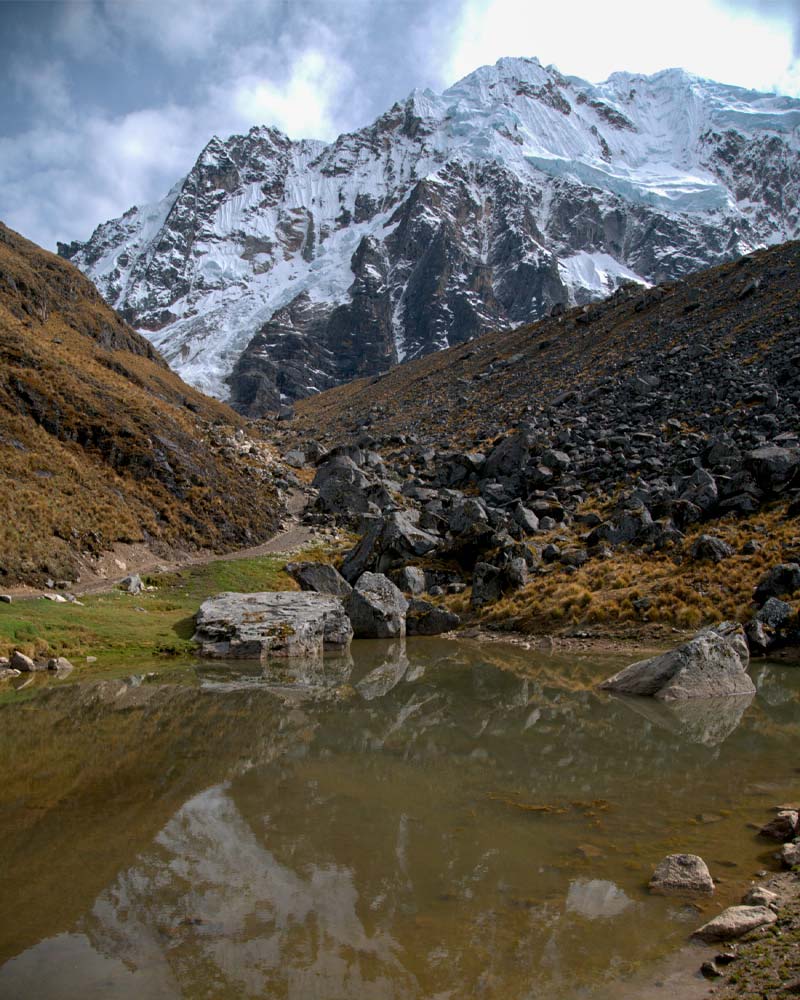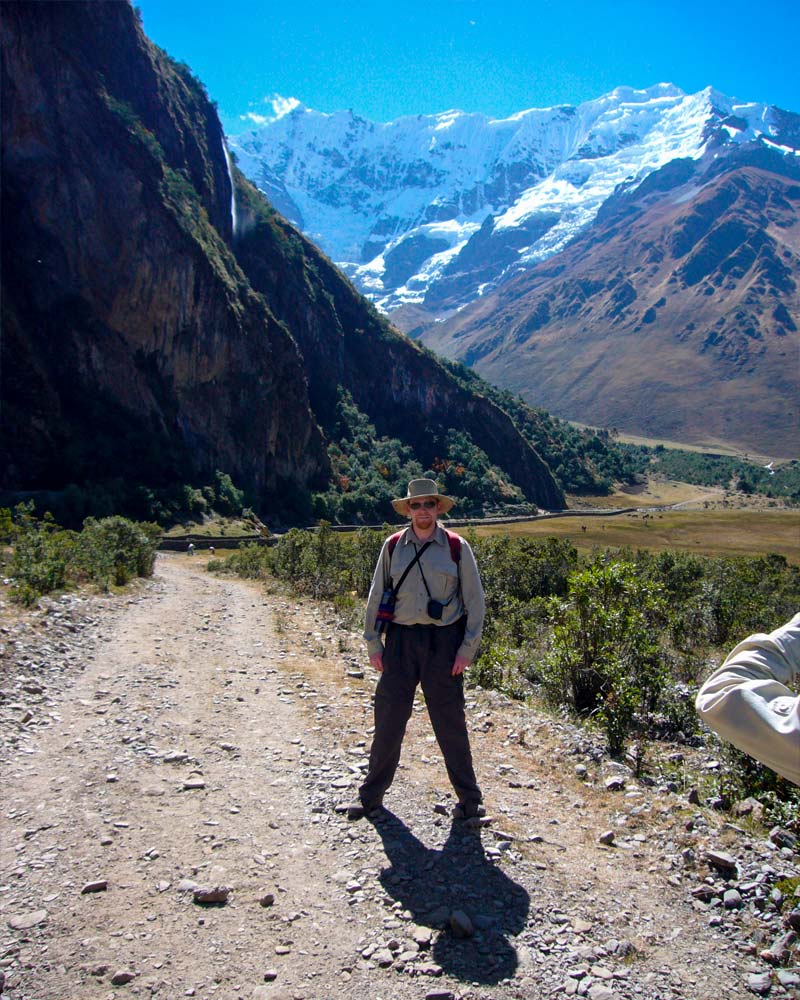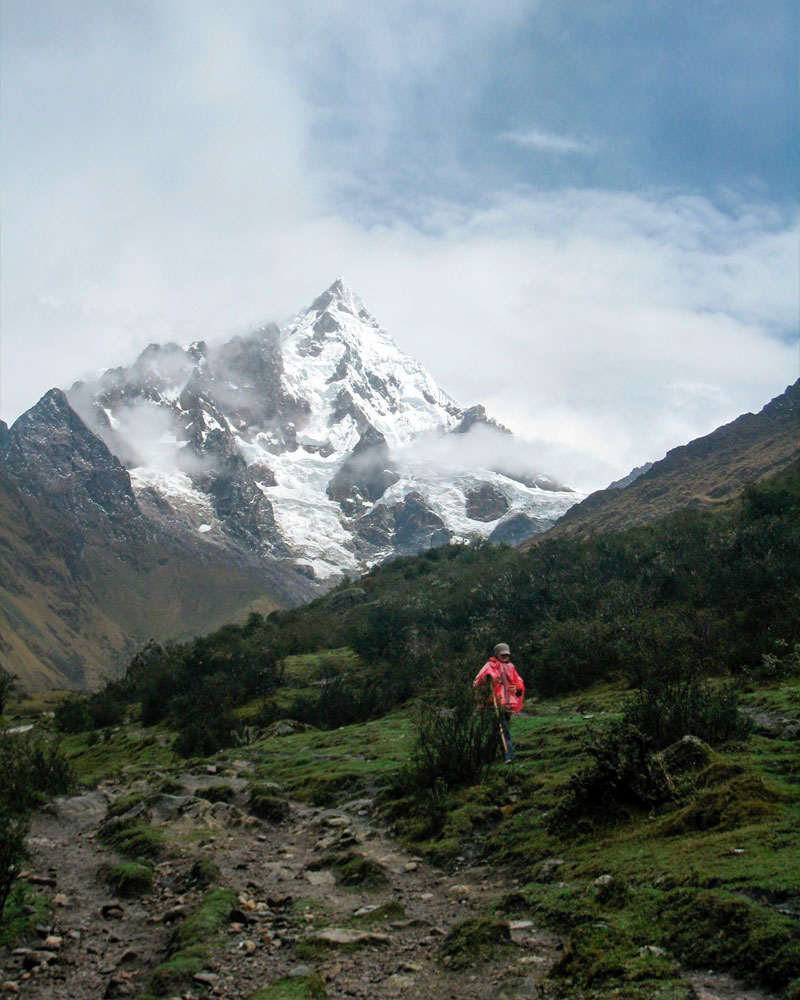
The snow of "Salkantay" is the Apu tutelar (main sacred mountain) of Cusco with 6271 meters of altitude. In the typical journey you crossed beautiful Andean landscapes, passed an opening of 5000 mtrs. and you will have the possibility of observing Condors and Alpacas in their natural habitat. This route is one of the most complete and beautiful that the Vilcabamba mountain range offers, it includes trips through the snowy Salkantay, camps near high Andean lagoons and hiking descents until you reach a tropical climate in the middle of the Jungle. The days of the trip are culminated with a visit to Machu Picchu. During the trip you can see flora and fauna typical of Andean areas and jungle, thermal waters lagoons and remote valleys. For this program our team is responsible for providing all the necessary facilities and requirements taking into account their safety and pleasant journey.
According to some authors, the name of this mountain is a contraction that comes from wild Salqa and Antay produce avalanches. The name of Apu, which in the Quechua language comes to mean lord, is usually defined in front of the great mountains that mean something sacred above the valleys. For example Apu Salkantay in the Vilcabamba mountain range.
Salkantay Mountain, also known as Salccantay, snow capped peak of Peru located in the department of Cusco; It constitutes one of the main elevations of the Cordillera de Vilcabamba, an extension of the Eastern Cordillera, a mountain branch of the Peruvian Andes. It reaches an altitude of 6,271 meters. It presents two peaks covered by snow, known as Salcantay China and Salcantay female, separated by a port that opens to the Santa Ana Valley in the province of Urubamba. Both the mountain pass and the fluvial course that is born there are called Salcantay. This river pours its waters into the Urubamba on its left bank. But you know why this mountain is sacred?
The Apus of the mountains are superior spirits considered protective of men and peoples. The Apus do not speak to humans, it is humans, through invocations, payments, rituals and prayers, who speak to the Apus asking for protection. The Apus are typically male spirits, although there are also female deities. In the Quechua language; spoken by the Incas, the plural of APU is apukuna.
 |  |  |
It could be based on an ecological reality, since meteorological phenomena such as snow, hail, rain, clouds, lightning and thunder often originate in the mountains. However, other common elements give clues to better understand the reverence that the ancient Peruvians felt for the mountains.
Worship of the sacred mountains
It is possible that a social cohesion has revolved around the cult of the sacred mountains. As the cases of ethnic identity that have been observed in many regions of the Andes. The mountains were perceived as a kind of gods of war; In the Inca culture, the mountains were Apus protectors of the people who lived nearby and they worshiped them. It is said that the Incas tried to appropriate the admiration felt by the pre-Inca peoples through the mountains, building places of worship such as the city of Machu Picchu. This in order to consolidate your government.
A very common belief in the Andes of Peru, is that the mountains (Apus deities Incas) are the owners of wild animals, so the hunting practiced by the Incas is linked to the mountains. The rugged territory of Machu Picchu hosts an enormous variety of fauna, bears, pumas, snakes, birds, etc. The building of the city would have provided additional reasons for the cult of the mountains. One of the deities that protects Machu Picchu, is the imposing Salkantay mountain. The word "wild" is "salqa" in Quechua and it is possible that this was the hunting place of Pachacútec, builder of Machu Picchu.
Now discover the most amazing adventure on Salkantay Trek to Machu Picchu the incredible alternative path to Machu Picchu. Explore The Salkantay Mountain the popular wild mountain in Peru and Enjoy the best views of natural landscapes along the Salkantay Trek.
The Salkantay is a mountain located in the Andes mountain range, in Peru. With an altitude of 6,264 meters, it is the second highest mountain in the Cusco region and one of the most important in Andean history and culture, due to its imposing presence and natural beauty, which have turned the snowy Salkantay into a very popular destination. Popular for nature and trekking lovers.
The word "Salkantay" comes from Quechua, the native language of the ancient settlers of the region and is composed of "salqa", which means "unsociable or wild", and "antay", which refers to the action of producing clouds or avalanches Therefore, the name "Salkantay" can be interpreted as "wild mountain."
In the belief of the people of the Andes, the Salkantay apu is seen as an important guardian that protects the communities of Limatambo, Mollepata, Machu Picchu and Choquequirao in the Vilcabamba mountain range, which is why the Salkantay is said to remain imposing and distinguished, unlike the Ausangate apu, which is considered very powerful. On the other hand, in the local Andean perspective, Salkantay is one of the most important and active deities, being seen as the father of all mountains, so for the Andean worldview this snow-capped mountain is considered sacred and has great spiritual importance. In fact, it is believed that he is an apu, a protective deity of the region.
As a show of devotion and gratitude to the apu Salkantay, people from local communities make different offerings in his honor, these can include food, such as coca, corn and quinoa, as well as flowers and other symbolic elements. Likewise, these offerings are deposited in sacred places near the snowy Salkantay, such as lagoons and apachetas (stone mounds), in this way the offerings are considered a way to establish a spiritual connection with the apu and to maintain a harmonious balance with the nature.
The Salkantay is a mountain located in the Cusco region, Peru. It has an altitude of 6,271 meters above sea level, which makes it one of the highest peaks in the Peruvian Andes, and it is also considered a sacred snow-capped mountain by local communities, who attribute great cultural and spiritual importance to it.
Salkantay Trek packages offer different options to travel one of the most impressive routes to Machu Picchu. They include treks that cross snowy peaks, turquoise lagoons, tropical valleys, and unique Andean landscapes, combining adventure and nature. These are the most outstanding:
Inca Trail, Machu Picchu and more